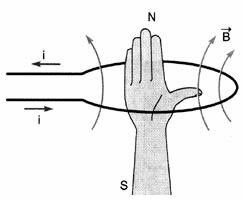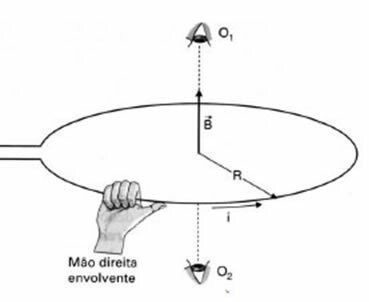Electric motors, transformers, electromagnets and other electronic equipment are devices that use a coil of wound wire that creates a magnetic field for a particular purpose.
A coil is made up of several turns. Here we will study the magnetic field formed by a single loop.
Let us consider a circular loop with center O and radius R, through which an electric current passes. Note that a magnetic field is established around the conductor, as seen in the figure below.
The magnetic induction vector at the center of the loop has the following characteristics:
1. direction perpendicular to the spiral plane

2. meaning given by the right hand rule*:

Thumb: direction of electrical current. Fingers: direction and direction of the magnetic field.
3. The intensity of the magnetic induction vector in the center of the loop depends on the strength of the electric current, the radius of the loop and the environment where it is located.
The equation that represents the strength of the magnetic field at the center of the loop is:

Where: B = magnetic field strength (Tesla T unit)
μ = magnetic permeability of the medium (unit
 )
) i = electric current intensity (Ampere A unit)
R = turn radius (meter m unit)
We then conclude that the magnetic field B is directly proportional to the electric current intensity i and inversely proportional to the radius R of the loop.
*Right hand rule:

Do not stop now... There's more after the advertising ;)
Imagine that your right hand is wrapped around the thread of the coil as in the figure above.
The thumb represents the direction of the electric current, the other fingers the direction and direction of the magnetic field.
By Kléber Cavalcante
Graduated in Physics
Brazil School Team
Electricity - Physics - Brazil School
Would you like to reference this text in a school or academic work? Look:
CAVALCANTE, Kleber G. "Magnetic Field at the Center of a Circular Spiral"; Brazil School. Available in: https://brasilescola.uol.com.br/fisica/campo-magnetico-no-centro-uma-espira-circular.htm. Accessed on June 27, 2021.


